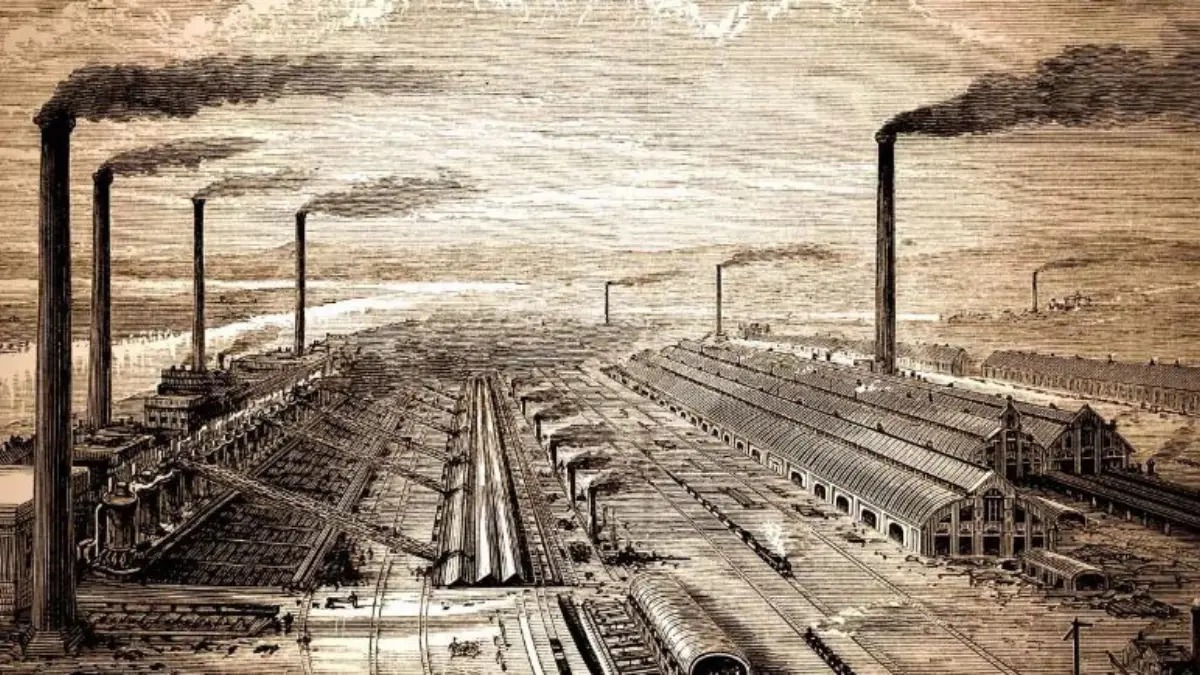The three Industrial Revolutions brought distinct learning and social changes to India, but their impact was shaped by colonial exploitation and, later, post-independence progress. The First and Second Industrial Revolutions occurred under British rule, leading to the decline of traditional artisanship and indigenous industries. The First IR turned India into a raw material supplier while dismantling its thriving textile and handicraft sectors, pushing a large population into agrarian distress. The Second IR introduced mechanization, railways, and large-scale industries like steel and textiles, but these developments primarily served British economic interests, reinforcing India’s dependency and widening economic inequalities. Education became more structured, but British policies prioritized English literacy over indigenous knowledge systems, creating an elite administrative workforce rather than innovators.
In contrast, the Third Industrial Revolution, marked by the internet, electronics, and IT, occurred post-independence and allowed India to benefit—albeit partially. India successfully leveraged its capable workforce in the global economy, particularly in IT and service sectors, but innovation and leadership remained far ahead in Western nations. While India became a hub for skilled labor, software services, and outsourcing, it lagged in technological innovation, R&D investments, and breakthrough inventions. Despite notable advancements in space, pharmaceuticals, and digital infrastructure, India remained largely a consumer and executor rather than a leader in global technological transformation. However, with increased focus on indigenous innovation, digitalization, and entrepreneurship in recent years, India is now striving to bridge this historical gap.
Impact of the First Industrial Revolution on India
While it primarily impacted Britain and Western Europe, its repercussions for India profoundly reshaped its economy, society, and colonial relationship with Britain. India’s experience was quite different, largely due to British colonial rule. This was a revolution that crushed India’s economy.
Deindustrialization of India’s Traditional Economy
Before British colonization, India was a major global producer of textiles, contributing 25% of global industrial output in 1750 (Maddison, 2001). India’s share in global GDP fell from 24.4% in 1700 to 4.2% in 1950 (Angus Maddison, The World Economy: A Millennial Perspective, 2001).
Data on Textile Industry Decline
| Year | Indian Textile Exports
(% of British Imports) |
British Textile Imports to India (in £ million) |
| 1800 | 33% | Negligible |
| 1830 | 8% | 1.0 |
| 1850 | 2% | 10.0 |
| 1870 | <1% | 27.0 |
Before British rule, India had a thriving textile industry, especially in cotton and silk. Indian handwoven fabrics like Muslin, Chintz, and Calico were globally renowned. However, the Industrial Revolution in Britain led to mechanized textile mills producing cheaper, mass-produced fabrics. It contributed to the destruction of India’s handloom sector due to British policies that promoted imports from England while imposing heavy taxes on Indian-made goods. The result was a loss of livelihood for millions of weavers and artisans, leading to large-scale unemployment.
British economic policies converted India into a supplier of raw materials (cotton, indigo, jute) and a market for British finished goods. The “Drain of Wealth” theory (as proposed by Dadabhai Naoroji) explains how the wealth generated in India was siphoned off to Britain, stunting India’s economic growth. British monopolies in trade led to the decline of traditional industries and forced dependency on British goods.
The industrial demand for raw materials led to the expansion of cash crops (cotton, jute, and indigo) at the cost of food crops, causing frequent famines. The British-imposed Charter Act of 1813 ended the monopoly of the East India Company, allowing British manufacturers to flood Indian markets with machine-made textiles. Permanent Settlement (1793) imposed high land revenue, leading to peasant indebtedness. In the Great Bengal Famine (1770), nearly 10 million deaths occurred due to excessive taxation and crop failure.
It resulted in an infrastructure development for British interests. The British introduced railways (1853), telegraphs, and roads primarily to facilitate raw material transport and control India efficiently. While railways modernized transportation, they did not contribute to industrial growth in India as in Britain. By 1900, India had 25,000 miles of railway lines, but they primarily benefited British industrial needs.
Unlike Europe, India did not experience an indigenous industrial revolution due to systematic colonial suppression. The British policies deliberately stifled native industrial growth, ensuring that India remained a raw material supplier rather than an industrial competitor. Indian entrepreneurs like Dwarkanath Tagore and Jamsetji Tata made significant efforts to establish industries. Still, they faced severe restrictions, including discriminatory tariffs, lack of state support, and British monopolization of critical sectors like textiles and steel. While Europe witnessed state-backed industrialization, India’s industrial aspirations were crushed by policies favoring British manufacturers, leading to the deindustrialization of India’s once-thriving handicraft and textile sectors.
The annual economic drain from India to Britain was estimated at £30 million by the late 19th century (Naoroji, Poverty and Un-British Rule in India).
Economic Indicators of Decline
| Indicator | 1750 | 1900 |
| India’s Share in World GDP | 24.4% | 4.2% |
| Literacy Rate | ~25% | ~6% |
| Life Expectancy | 35-40 years | ~25 years |
The First Industrial Revolution benefited Britain but led to India’s deindustrialization. India, once a major exporter of textiles, became an importer of British goods, suffering economic exploitation. The long-term impact was India’s delayed industrialization, which only gained momentum in the 20th century, particularly after independence.
Impact of the Second Industrial Revolution on India
The Second Industrial Revolution brought significant advancements in steel production, electricity, chemical industries, petroleum, and mechanized manufacturing. While it transformed economies in Europe, the United States, and Japan, India’s industrial progress was hindered by British colonial policies, which prioritized resource extraction over domestic industrial growth.
India’s role in the Second Industrial Revolution remained limited, as British policies kept it primarily as a raw material supplier rather than an industrial hub. The demand for cotton, jute, and iron ore surged, reinforcing a colonial economy that prioritized British industries at the expense of India’s self-sufficiency. Indian entrepreneurs faced severe restrictions, making it difficult to establish competitive industries. While Britain benefited from mechanized textile production, Indian handloom industries suffered, causing widespread unemployment among traditional artisans. The introduction of British-manufactured goods led to economic distress, forcing many Indians to shift to subsistence farming under exploitative revenue policies.
During this period, significant infrastructure developments took place in India, but they were primarily designed to serve British economic and administrative interests. The railways expanded (1870s onward) rapidly, but instead of fostering industrialization within India, they facilitated the movement of raw materials from the interior regions to ports for export. Telegraph and postal services improved communication, but they were mainly intended to strengthen British control rather than support local businesses. Ports were modernized to streamline the export of Indian resources while ensuring the smooth inflow of British-manufactured goods into the Indian market, deepening the dependency on imports.
With the gradual emergence of industrial centers in Bombay, Calcutta, and Madras, a new working-class population began to take shape. However, factory conditions were harsh, with long working hours and minimal wages, leading to early labor unrest and industrial strikes (e.g., Bombay Mill Strikes, 1890s). While British entrepreneurs dominated major industries, a few Indian industrialists managed to establish businesses despite colonial restrictions. Jamsetji Tata founded India’s first steel plant (TISCO, 1907) in Jamshedpur. Ghanshyam Das Birla and Walchand Hirachand also emerged as key Indian business figures. The social structure continued to be influenced by British policies, which reinforced economic disparities and increased agrarian distress. In response to growing economic exploitation, nationalist leaders spearheaded movements like the Swadeshi Movement, encouraging Indians to boycott British goods and support indigenous industries.
While industrialization in Europe and the United States led to rapid urbanization and technological progress, India remained largely rural and economically dependent on Britain. Western nations experienced an industrial boom that expanded labor rights, improved wages, and increased production efficiency. In contrast, India’s industries struggled under British-imposed economic constraints that stifled large-scale manufacturing. While Europe saw advancements in infrastructure to support industrialization, India’s railways and telecommunication systems were primarily built for resource extraction and administrative control rather than fostering domestic economic growth.
By the end of the second Industrial Revolution (1870–1914), India began to recognize the power of industrial control, self-reliance, and the exploitative nature of colonial rule. This realization sparked an economic consciousness that inspired Indian entrepreneurs to establish their own industries, though largely by imitating successful global models. The early sparks of indigenous industrialization laid the groundwork for India’s economic aspirations, which would later gain momentum in the fight for self-reliance and independence.
Impact of the Third Industrial Revolution on India
The Third Industrial Revolution, commencing in the 1950s, marked a global shift from mechanical and analog technologies to digital electronics and information technology. This era introduced innovations such as semiconductors, computers, and the internet, fundamentally transforming industries worldwide. This era was marked by advancements in electronics, telecommunications, and renewable energy & transformed global economies. While developed nations rapidly embraced these changes, India’s journey was influenced by post-independence industrial policies, economic reforms, and globalization.
Post-independence, Nehru-led India adopted a socialist and protectionist economic model, which, while aiming for self-reliance, led to limited integration with the global economy. By the late 20th century, this approach resulted in economic stagnation. The establishment of PSUs (Public Sector Undertakings) like BHEL, HAL, and SAIL marked India’s first steps toward industrial self-reliance. However, restrictive License Raj policies (1947–1991) and bureaucratic inefficiencies hindered private sector growth, preventing India from fully embracing the Third Industrial Revolution in its early years. Recognizing the need for change, leaving the Nehruvian socialist and protectionist economic model, India initiated economic liberalization in 1991, transitioning towards a market-oriented economy.
By the 1990s, India’s economic liberalization, led by Prime Minister P.V. Narasimha Rao and Finance Minister Dr. Manmohan Singh, paved the way for private sector expansion. The rise of information technology (IT) and software services, led by companies like TCS, Infosys, and Wipro, positioned India as a global IT hub. The development of telecommunication networks and the internet revolution in the 2000s further accelerated digital transformation.
With growing concerns over climate change, from 2014 onwards, India has significantly invested in solar and wind energy, emerging as one of the largest renewable energy producers. While Western nations led the semiconductor and automation revolution, India initially lagged due to policy constraints and technological dependency. However, with rapid advancements in IT, telecom, and digital finance, India has leapfrogged in several areas, particularly in mobile technology, software exports, and digital payments (UPI revolution). Unlike the Second Industrial Revolution, where India merely imitated global models, the Third Industrial Revolution saw India developing its technological expertise and leading in specific domains like pharmaceuticals, space technology (ISRO), and digital governance.
The country became a global leader in IT and services, with the sector growing to $250 billion and employing nearly 5 million people. India’s industrial production surged, AI and digital initiatives expanded, and the startup ecosystem thrived. While challenges like manufacturing dependency on China remain, India is making strides toward self-reliance and innovation in technology-driven industries.
India’s industrial journey reflects a transition from colonial exploitation to economic awakening and finally to digital transformation, positioning itself as a rising global economic force.
The views and opinions expressed here belong solely to the author and do not reflect the views of BlueKraft Digital Foundation.







